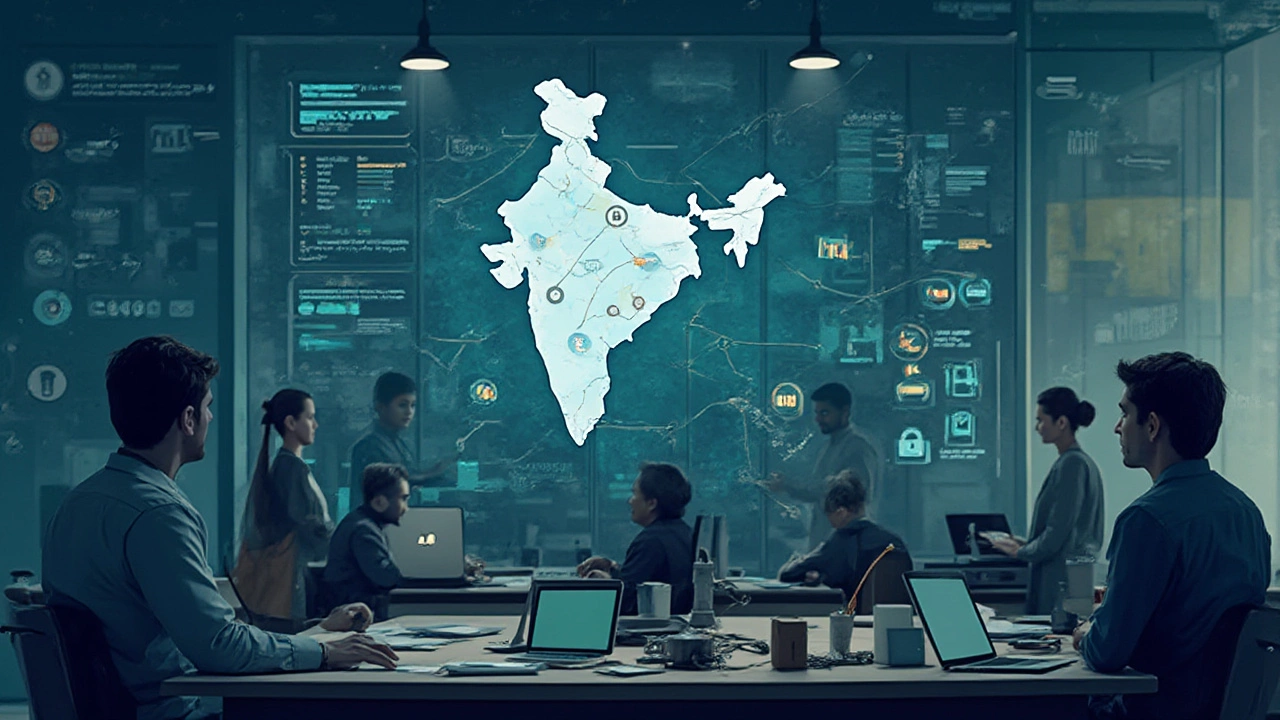Ever wonder why that movie site you used last week suddenly stopped working, or why your friend in London could open something you only see a blank page for? In India, internet censorship isn’t just a buzzword — it's a real, active force changing the websites you can visit and what online content you see. From pirate movie hubs to banned social networks, the list of blocked domains in India grows year after year, shaping the very way the country’s web surfers move around the internet.
Why Domains Get Blocked in India
Picture this: You type in a website address and, instead of your favorite show, you see a government message saying the site is blocked. That’s not a glitch — it’s the direct outcome of India’s approach to controlling digital spaces. The reason? It’s not always about safety. Sometimes it’s about politics, copyright, or even business wars. For instance, government bodies like the Department of Telecommunications (DoT) and the Ministry of Electronics and Information Technology (MeitY) have full authority to issue blocking orders to Internet Service Providers (ISPs). Each order often comes citing the Information Technology Act, 2000, or instructions from court orders.
One of the biggest triggers is copyright protection. Sites streaming pirated Bollywood movies — like Tamilrockers or Filmywap — are hit first. In 2023, MeitY announced blocking over 1,400 websites alleged to host or link pirated content, especially during blockbuster releases. Pirate domains adapt quickly, often launching new URLs overnight, sparking a constant game of digital whack-a-mole. Then you have social media bans — back in 2021, TikTok and over 100 Chinese apps were abruptly blocked over data security and sovereignty concerns. That move left millions searching for alternatives, and plenty of homegrown apps rushed to fill the gap.
Political content also lands in the crosshairs. Activist blogs, news platforms with dissenting views, or even social campaigns sometimes find themselves locked out, all justified by the pretext of “public order” or “national security.” For instance, access to popular news sites like The Kashmir Walla was axed in 2023, with little explanation offered to their readers. It’s not just big names either — even Reddit threads or Tumblr blogs sometimes disappear after a government order.
But the story goes beyond big, dramatic takedowns. Court orders, especially from local High Courts, play a surprising role. Bollywood studios are known for filing “John Doe” suits — blanket legal actions allowing hundred of pirate URLs to be blocked proactively just before a film’s release. Legitimate sites sometimes get accidentally swept up, leaving users angry and webmasters scrambling to appeal, which doesn’t always work fast — if at all.
Which Domains Are Commonly Blocked?
The actual list isn’t public, which makes it tricky to keep track. Ask ten Indians what’s blocked, and you’ll get ten different answers — but some patterns are very clear. Movie piracy websites top the charts. Names like Tamilrockers, Movierulz, Filmyzilla, and 123Movies are frequently blocked, especially around big film releases. The government, often collaborating with content producers, cracks down aggressively, yet copycat sites pop up almost immediately, just swapping in a tiny tweak to the domain name. This cycle’s gotten so intense, YouTube channels and Telegram groups dedicated to pirate content have also been permanently blocked.
Then come the file-sharing and adult content sites, with domains like The Pirate Bay, KickassTorrents, and many major adult sites routinely inaccessible in India. It’s not just about copyright — sometimes it’s morality, sometimes policing. For example, in 2022, ISPs across major cities restricted access to dozens of pornography portals, based on both government orders and Supreme Court interventions.
Social networks aren’t immune. After the 2020 Indo-China border clash, the government blocked TikTok, WeChat, Shareit, and dozens of other popular Chinese apps “for security reasons.” This ban extended to their various web portals, and, in practice, hundreds of associated domains are now unreachable for Indian users. Even LinkedIn saw partial restrictions in Kashmir during periods of unrest, showing how broad and sudden these blocks can be.
Political or activist sites get targeted, too — Newsclick, The Kashmir Walla, and sections of The Wire have all faced partial or full blocks, often with little transparency. Sometimes errors creep in — local ISPs have mistakenly blocked platforms like GitHub or Vimeo after a vaguely-worded order, causing chaos for Indian developers and creators who rely on these services for daily work.
Messaging platforms are now squarely in focus. Periodic bans on WhatsApp, Telegram, and Signal sometimes happen during exam season (to prevent cheating) or in times of civic unrest, especially in Kashmir. These bans might be temporary but leave a huge digital blackout for those affected. Don’t be surprised if your VPN or proxy site goes dark — the government regularly orders ISPs to block access to VPN websites, too, making it tough for regular folks to skirt the censorship wall.

How Blocks are Enforced: The Mechanics Behind the Wall
This isn’t about broken websites. When domains get blocked in India, it’s systematic and serious. ISPs get a confidential government notice and must comply within hours, sometimes minutes. Many use DNS filtering — essentially tampering with the internet’s address book to make sure certain domains lead to nowhere. Others redirect you to a government page, while some just display a bland “site can’t be reached” message. Tech-savvy users can sometimes sneak around this by using public DNS resolvers like Google DNS or Cloudflare, but ISPs are catching up and blocking these routes, too.
Sometimes, the block is at the URL level, not just the domain. If a whole site isn’t problematic but a few pages within it are, those specific links get blacklisted. This happened with Facebook and Twitter posts during periods of unrest — users in India would notice individual tweets or posts “unavailable” while the rest of the platform ran as normal.
Mobile data providers take it even further. Geo-specific bans pop up, especially during protests or exams. Kashmir, for instance, has seen hundreds of internet blackouts since 2012, with even basic Google services sometimes inaccessible. The moment the area is deemed volatile, authorities cut off access or tightly throttle speeds, making streaming, video calls, and even WhatsApp voice notes impossible.
The bureaucracy runs deep. There’s no published “master list” of blocked domains. Even RTI (Right to Information) requests for up-to-date lists are often stonewalled, cited as “confidential for security reasons.” Courts and government agencies work in tandem, and appeals are slow. It’s common for affected platforms to get a sudden notice to remove specific content or risk being entirely blocked within hours — not days or weeks. Sometimes, reversals happen, but often after heavy public backlash or negotiation.
The tools have gotten smarter. Deep Packet Inspection (DPI) lets ISPs recognize forbidden domains by scanning traffic signatures, not just URLs. VPN and proxy traffic is now routinely detected and throttled. Savvy users hop between VPNs and proxies that last only days before being axed in the next ISP-level sweep. Some people switch to encrypted browsers or Tor, which gets blocked off and on, depending on the year.
For most users, reloading won’t help. Even switching browsers or clearing your cache gets you nowhere — these blocks are at the network level, so every device on your home Wi-Fi will get stopped in its tracks.
The Impact: Who Loses Out and Who Gets Creative
The first group to lose out is the obvious one — regular users hoping to catch a new movie or tune into niche news. Movie buffs, researchers, students, journalists, and entrepreneurs feel the pinch most. Whole communities are shut out from blogs, research repositories, or global forums. There was a recent case where Indian scientists found access to academic archives like Sci-Hub and LibGen abruptly blocked just before major deadlines — imagine the collective panic in study groups and lab WhatsApp chats that evening.
Startups and small businesses suffer, too. Many Indian developers rely on GitHub or Stack Overflow; when an ill-worded block order hits these sites, entire coding teams face hours or days of downtime. Event organizers using sites like Meetup or Eventbrite found themselves without ticketing options after their domains were briefly blocked in late 2022 owing to a technical over-block. These ripple effects add up to real money lost and productivity wasted. For news portals, activist groups, or dissidents, domain blocks are more than an inconvenience — they’re a direct attack on visibility, fundraising, and organizing. In a viral 2023 incident, activists reported being blocked on all mainstream websites where they raised funds — within hours, cash flows for medical and legal aid dried up, putting real lives at risk.
Internet censorship also stifles innovation. Young coders and creators, searching for creative commons media or collaborating with international peers, suddenly face digital walls for no fault of their own. The irony? While official domains are blocked, determined users still find workarounds — switching to ever-changing mirror sites, private Telegram channels, encrypted folders, or newly-minted VPNs. The arms race never seems to end, but security risks for users, like malware-infested sites and scams, ramp up with each new “unofficial” path.
Some platforms throw up their hands and walk away altogether. Big international news sites or forums — think Medium or Archive.org — have seen partial or incomplete service in India, sometimes for months, before the issue is quietly resolved or dropped. Thousands of small creators relying on these platforms lose audience and income, and their voices go largely unheard in the debate.

Tips, Tools, and Workarounds: Staying Informed and Safer
If you’re trying to dodge a domain block, there are a few tricks — but tread carefully. VPN services are the go-to workaround, but not all work reliably, and some can put your privacy at risk. Make sure you pick a service with a genuine no-logs policy, good encryption, and a strong reputation. Free VPNs often leak data or load you up with malware, so think twice before downloading that “anonymous” plugin everyone’s sharing on a forum.
Public DNS providers can help in some cases. Services like Cloudflare’s 1.1.1.1 or Google’s 8.8.8.8 were the favorites for bypassing DNS blocks. ISPs have started clamping down here, but they sometimes work for smaller or newly-banned domains. If you’re really determined, the Tor Browser or specialized encrypted browsers can get you through, though speeds will be slow and the experience clunky.
To check if sites are blocked or it’s just an issue at your end, services like Blocked.org.in offer real-time site tests. Some web proxy sites will load basic pages but strip out images or scripts, so don’t expect streaming or video to work. Techies sometimes use SSH tunnels or advanced proxy chaining — but these come with a learning curve and serious privacy concerns if you don’t know what you’re doing.
- If you run a website, bookmark the MeitY or DoT circulars — new bans are often announced suddenly.
- For creators and business owners, have backup domain options and mirror sites ready in case yours is targeted.
- If you use banned services for legit purposes (like developers on GitHub), talk to your ISP about whitelisting or join larger petitions on social media. Past cases show that coordinated pressure can help overturn accidental blocks, especially if business operations are disrupted.
Above all, stay smart and stay safe. Domain blocks aren’t only about what you stream or read — they’re part of a bigger digital landscape, where who gets access and who’s kept out is constantly in flux. If you’re ever confused about why a site is down, it’s not just you — there’s a whole maze of laws, tech, and politics at work behind every “Access Denied” page you see.
